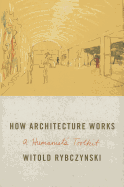
In How Architecture Works, Witold Rybczynski's practiced eye roams freely from the weathered metallic skin of Frank Gehry's Disney Concert Hall to the simple seamless pipe railings of the emergency stairways in Rem Koolhaas's Seattle Public Library. He is equally perceptive on pilgrimages to masterpieces like Frank Lloyd Wright's Fallingwater or Moshe Safdie's Crystal Bridges Museum, which sits "fragmented, self-effacing, nestled into the landscape."
Rybczynski's voice, honed over nearly 20 books on architecture and related subjects, is eloquent and free of polemics or prejudice. His goal is simply to discover "what makes a building memorable.... Why does this building touch us?" He organizes his "humanist's toolkit" according to basics of good design, starting with an idea and working through the site, plan, structure, skin and finally the details. Because Rybczynski includes only buildings he has visited personally, How Architecture Works is more a stroll with a knowledgeable friend than a vigorous workout with a trainer. When he stops in Golden Gate Park between the Renzo Piano California Academy of Sciences and the Jacques Herzog and Pierre de Meuron de Young Museum, he notes the contrasts. Piano's "axial symmetry and the mirroring of forms provide a clear and simple sense of orientation," while the de Young "doesn't have an obvious structure, but it has character, and the fractured spaces evoke earthquakes and shifting tectonic plates."
With Rybczynski as our guide, we see what makes cool buildings cool. --Bruce Jacobs, founding partner, Watermark Books & Cafe, Wichita, Kan.

